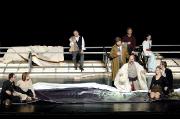Mozart: Die Entführung aus dem Serail (Carydis) (Review)
Introduction
It's always going to be controversial stating matters of opinion, but here goes. This is Mozart's second great opera, following Idomeneo (and eleven others), whose plot involves three characters who have been kidnapped by pirates and sold into a Turkish court.
The three - Konstanze, her maid Blonde, and the maid's boyfriend, Pedrillo, have become fixtures (albeit unwilling fixtures) of the Court of Pasha Selim and, for the ladies at least, the Harem. Pasha Selim has taken a fancy to Konstanze, but being an Islamic apostate (converted from Christianity dontcha know), has not fully got the hang of the power he should be able to wield over all the women in his Court. He professes his desire for her, yet will not do anything until she concedes - which she is, to be fair to her, considering, as he seems a nice chap when all is said and done.
Blonde, an English girl, also has her admirer, in the shape of Selim's chief servant, Osmin. Osmin is less gentlemanly, but will obviously not force himself onto the girl should this bring about a swift separation - namely of his head from the rest of his over-indulged body...and to be honest, being an English girl, Blonde isn't going to let him have his way with her anyway, as they're not like that you know.
Pedrillo is naturally aggrieved with all this attention towards his young lady, and so makes it his role in life to annoy Osmin as much as possible. There is no love lost between these two.
Into the mix comes Belmonte, a Spanish gentleman who is desperate to claim back Konstanze and her colleagues. He arrives at the palace pretending to be an Italian architect who would like to prove himself to Selim, but the four start plotting their escape immediately.
Osmin, despite having been drugged by Pedrillo, finds out about the plan, and they are all caught, with threats of immediate and painful deaths. It doesn't help that Belmonte is actually the son of the Pasha's arch-enemy, so his death will be even more welcome.
Selim, however, has a change of heart, and in a gesture of the greatest magnaminity, releases the lot, making Belmonte promise that his father finds out about how things could have been so much different. Osmin isn't best pleased, but that's life.
Video
A very acceptable NTSC transfer. All the appallingly garish colours are brought out wonderfully, and there's no noticeable problem with any darker parts of the set.Audio
The orchestral sound is certainly very clear (you definitely get a sense of 'piccolo' in the overture), which is nice, but sometimes almost covers the voices. It obviously doesn't help that the vocal parts have such a wide range that certain registers are not always going to be as powerful as others for all singers, but when even Kurt Rydl has problems with his lower register sounding clearly then perhaps a very subtle use of the head mics used would have been an idea.This being a Singspiel of course, there is rather a lot of spiel, and no recits at all (apart from a few accompanied moments) so the cast need to get the spoken text out to a large theatre without straining things before the music strikes up again. On the DVD at least, the spoken parts are loud and clear.
Extras
We have a 'documentary' entitled 'Behind the scenes' which is split up into 4 sections. For the life of me, I couldn't work out how to play the lot together, so I can only imagine the option wasn't there. Each section really isn't that long, and as a whole is just of passing interest. Most annoyingly, you learn absolutely nothing about the whys and wherefores of Johan Simons' production. The dress and furniture suggest relatively recent times, but that's as far as I could fathom.More interesting is the all-too-brief contribution from Steven Van Watermeulen who plays Pasha Selim, a purely speaking role. This was his first foray into opera, and it's great to hear his opinions on his fellow cast members and how he needed to act around them, especially while they were in full flow.
Some very short chats from the main members of the singing cast are added as well, but these consist mainly of character descriptions from which you learn little more than you knew already (assuming you have read the booklet and seen the opera).
A very minor niggle (and one which is possibly not 'fixable') - the DVD numbers on disc 2 don't match the numbers laid out in the booklet, and so anyone with slight Attention Deficit Disorder may get a bit lost. Also, disc 2 gives you the option to play Acts 2 & 3, which is interesting, as you are already halfway through Act 2 by the time disc 1 is over.
Conclusion
I'm very pleased that Johan Simons has at least gone for a more serious interpretation of this work. It is often treated as some sort of musical pantomime, with over-the-top stereotypical Turkish characters and a grotesque, comedic villain in the shape of Osmin. Opera Buffa it ain't however, and this production quite rightly concentrates on the emotional struggle created between the love triangle that is Konstanze, Selim and Belmonte, showing clearly how love is far more transient than many believe.Nowadays, of course, there is always going to be a more political slant to stories such as this, it being a clash between Christian and Islamic cultures. When first performed, the Turkish world, despite being close to Austria, was still one of relative mystery and the perceived inherent danger of the unknown was as fascinating then as it is today. The libretto clearly asks questions of the 'other' religion, and almost pokes fun at certain Prophets and cultural beliefs, but then the libretto is of another age, and so should be treated as 'of its time' without adding any other apparent meaning.
All the characters (apart from perhaps Blonde, who is probably the most 'together' of the lot) show a great vulnerability, despite shows of extreme arrogance in places, especially from Belmonte. Even Osmin (brilliantly acted by Rydl) becomes a more sympathetic character than you often see him, and this is one of the great successes of the production.
Singing-wise, things are variable.
Laura Aikin (Konstanza) appears to have a bit of trouble in 'Ach, ich liebte, war so glücklich' but then this is her first aria, and warming up is something everyone has to do after such a long wait before you come on. Everything is absolutely fine afterwards however, and she is absolutely superb in Martern aller Arten (which precedes the break in the performance - and, just as a matter of interest, is the aria full of scales that is screeched by her with the parasol inAmadeus, and which is complained bitterly about by Salieri).
Kurt Rydl (Osmin), as I mentioned, is a superb character actor, and is the only cast member you really can't take your eyes off while on stage. His voice booms with a very satisfying depth, whether singing or speaking, and you know that here is a man who has had years of experience in roles such as this. Unfortunately, there is a little too much buffa in his singing, missing much of the melodic elements and relying on a few too many declamatory 'shouts' to make a point. Full marks for making you feel something for the character though!
Edgaras Montvidas (Belmonte) and Michael Smallwood (Pedrillo) produce two fine perfomances, Smallwood carying himself slightly better over the orchestral sound, and Montvidas (with Aikin's help) seeming more like the slimy character he really is, deep down.
Mojca Erdmann (Blonde) was new to me, and quite a revelation. She is perhaps not the greatest actresses of all time, but when she sings Durch Zärtlichkeit und Schmeichein you really want to sit up and listen.
Constantinos Carydis handles the music with great style, wit, and where necessary, gravitas (now there's a word I don't often use), and The Netherlands Chamber Orchestra seem to enjoy the experience (when the camera's on them at least), making everything sound fresh and exciting (with some fine woodwind solos) - which, of course, it is, being only the second great opera from the great man.
This is, overall, a very fine performance of an opera which is still often misunderstood, and considering it was recorded over three nights, fits together very well (I'm assuming some was filmed during a dress rehearsal if I am to believe the dates mentioned in the sleeve notes). It deserves to be seen often, if only to have fun in guessing as to why the production is as it is.












































Your Opinions and Comments
Be the first to post a comment!